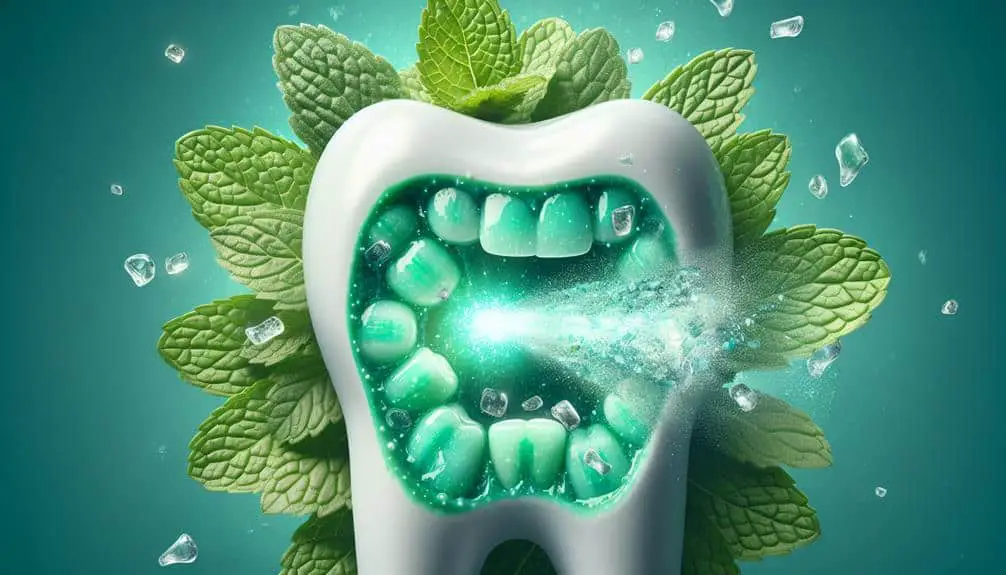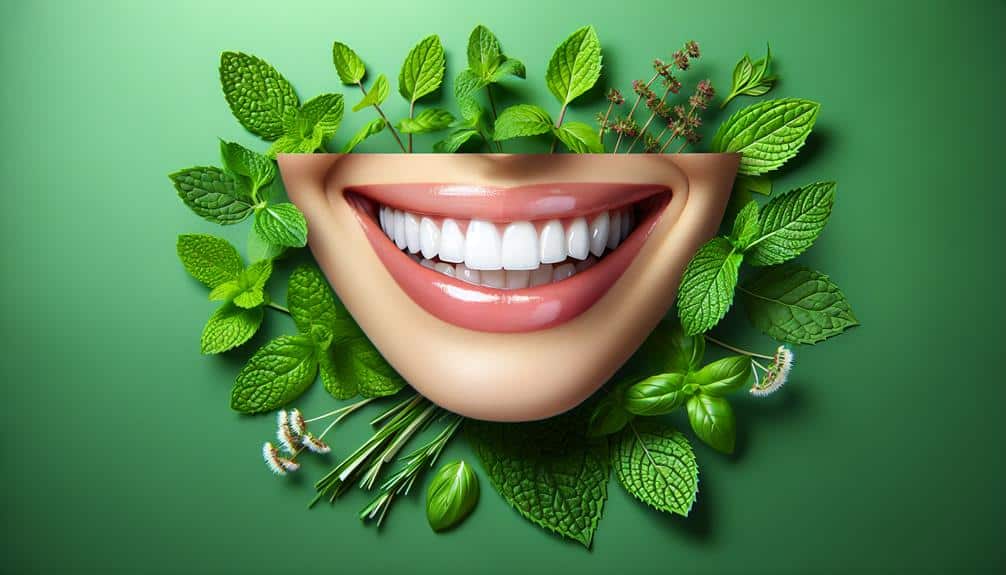Whitening toothpaste enhances your breath freshness by using ingredients like essential oils and baking soda to target odor-causing bacteria effectively. These components work to reduce compounds that are responsible for bad breath, ultimately promoting better overall oral hygiene. The science behind whitening toothpaste and its key ingredients play a significant role in combating odor and ensuring a lasting minty freshness.
Key Points
- Essential oils and baking soda in whitening toothpaste neutralize acids and kill bacteria, promoting fresher breath.
- Whitening agents like hydrogen peroxide oxidize bacteria, breaking down compounds that cause bad breath.
- The oxidation process by whitening agents effectively reduces halitosis and enhances oral freshness.
- Components in whitening toothpaste target odor-causing bacteria, contributing to better breath quality.
- Enamel protection and stain removal by whitening toothpaste lead to improved oral hygiene and fresher breath.
The Science Behind Whitening Toothpaste
When you brush with whitening toothpaste, the key aspects work to remove surface stains from your teeth, revealing a brighter smile. However, the benefits of whitening toothpaste go beyond aesthetics. The science behind whitening toothpaste involves enzyme reactions and enamel protection.
Enzymes in whitening toothpaste break down molecules responsible for stains on the tooth surface. These enzyme reactions help to lift and remove the discoloration, resulting in a visibly whiter smile. Additionally, whitening toothpaste often contains abrasives that aid in the gentle scrubbing away of stains, further enhancing the whitening effect.
Moreover, enamel protection is an important aspect of whitening toothpaste. While whitening agents work to brighten teeth, they must also safeguard the preservation of enamel. Many whitening toothpaste formulas incorporate ingredients that strengthen and shield the enamel, preventing damage during the whitening process. By maintaining enamel integrity, whitening toothpaste not only enhances the appearance of your smile but also safeguards the health of your teeth.
Key Ingredients for Fresh Breath
To enhance breath freshness, whitening toothpaste incorporates key ingredients that target odor-causing bacteria in your mouth. Proper oral hygiene is essential for combating bad breath, and whitening toothpaste contains ingredients like essential oils that help kill bacteria responsible for unpleasant odors. Essential oils such as peppermint, eucalyptus, and tea tree oil have vital properties that can freshen breath by reducing the bacteria that cause bad odors.
In addition to essential oils, whitening toothpaste often contains baking soda, known for its ability to neutralize acids in the mouth and help remove plaque that harbors bacteria. Baking soda also has gentle abrasive properties that aid in removing surface stains, contributing to a brighter smile and fresher breath.
Furthermore, many whitening toothpaste brands include fluoride, a mineral that not only strengthens tooth enamel but also helps in reducing bacteria and preventing tooth decay. Fluoride plays an important role in maintaining good oral health and promoting fresh breath.
How Whitening Agents Combat Odor
Have whitening agents in toothpaste proven effective in combatting odor-causing bacteria in the mouth? Whitening agents, such as hydrogen peroxide and carbamide peroxide, play an essential role in reducing odor by oxidizing bacteria present in the mouth. These agents work by breaking down the molecules that contribute to bad breath, thereby tackling halitosis and enhancing freshness.
Oxidizing bacteria is a key mechanism through which whitening agents combat odor. When these agents come into contact with the bacteria responsible for causing bad breath, they initiate a reaction that breaks down the compounds leading to the unpleasant odor. By oxidizing these bacteria, whitening agents effectively reduce odor and contribute to overall oral hygiene.
Benefits of Whitening Toothpaste
Curious about the advantages of using whitening toothpaste for your oral care routine?
Whitening toothpaste offers several benefits that go beyond just brightening your smile. Here are three key advantages to ponder:
- Enamel Protection and Sensitivity Relief: Whitening toothpaste often contains ingredients that not only help to whiten teeth but also provide protection for your enamel. Enamel is vital for maintaining strong and healthy teeth, and certain whitening toothpaste formulations can help strengthen it. Additionally, many whitening toothpaste options are designed to be gentle on sensitive teeth, offering relief for those who experience discomfort with other whitening products.
- Stain Removal and Long-Lasting Results: One of the main benefits of using whitening toothpaste is its ability to effectively remove surface stains from the teeth. With regular use, you can achieve a brighter smile as the toothpaste works to lift and eliminate stains. Moreover, some whitening toothpaste brands offer long-lasting results, helping you maintain a whiter smile over time with consistent use.
Incorporating whitening toothpaste into your oral care routine can provide both aesthetic benefits and essential protection for your teeth.
Choosing the Best Whitening Toothpaste
When choosing the most appropriate whitening toothpaste for your oral care needs, consider examining the key ingredients for optimal results. To guarantee the toothpaste is effective in both whitening and maintaining oral health, look for ingredients that target tooth sensitivity and stain removal.
To address tooth sensitivity, opt for a whitening toothpaste that contains components like potassium nitrate or strontium chloride. These elements can help alleviate sensitivity while still providing whitening benefits. Additionally, fluoride in the toothpaste can strengthen enamel, reducing sensitivity over time.
For effective stain removal, seek whitening toothpaste with abrasives such as silica or baking soda. These abrasives work to gently polish away surface stains caused by coffee, tea, or smoking, revealing a brighter smile. However, be cautious with abrasive toothpaste if you have sensitive teeth, as they may cause discomfort.
Frequently Asked Questions
Can Whitening Toothpaste Cause Sensitivity in Teeth and Gums?
Using whitening toothpaste may cause sensitivity in teeth and gums. Sensitivity management is important; consider switching to toothpaste without whitening ingredients. Consult a dentist for alternative options for oral health care.
Are There Any Potential Side Effects of Using Whitening Toothpaste for Breath Freshness?
Using whitening toothpaste for breath freshness may have potential risks like increased sensitivity. Compare ingredients to make certain they are appropriate for you. Be cautious to prevent adverse effects on teeth and gums.
Is There a Difference in Effectiveness Between Natural and Chemical Whitening Toothpaste for Improving Breath Freshness?
When comparing natural and chemical whitening toothpaste for breath freshness, effectiveness varies. Studies show that natural ingredients may offer gentler solutions but can be less potent. Chemical options often provide quicker, more noticeable results, but may have stronger effects.
How Long Does the Freshness From Whitening Toothpaste Typically Last Throughout the Day?
Throughout the day, the freshness from whitening toothpaste typically lasts around 12 hours. Benefits include enhanced oral hygiene and confidence. Drawbacks may involve maintaining results through regular brushing and avoiding staining foods.
Are There Any Special Considerations for Individuals With Sensitive Teeth or Conditions Like Gingivitis When Using Whitening Toothpaste for Breath Freshness?
When using whitening toothpaste for breath freshness, manage sensitivity by choosing gentle formulas or alternating with desensitizing products. Monitor gum health closely; consider whitening alternatives like professional treatments for better results without exacerbating conditions like gingivitis.



